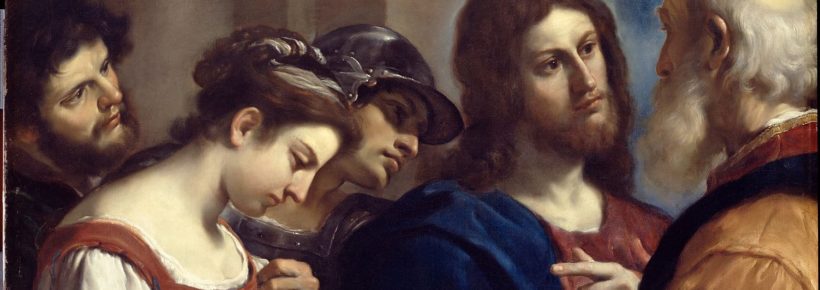Previous articles in this series:
- What Is the Theology of the Body?
- Human Dignity and the Conjugal Meaning of the Body
- The Beginning: The Original Unity of Man and Woman
- Purity of Heart
- Resurrection of the Body
- Christian Virginity and Celibacy for the Kingdom of God
- The Sacrament of Marriage
In our previous article we gave a summarized and simplified reflection on the Sacrament of Marriage as explained in the fifth cycle of catechesis (87-113) of St. John Paul II on the theology of the body. In this article, we continue our reflections, moving to the sixth and last cycle of the Holy Father’s catechesis (114-129), which treats of love and fertility.
The subtopics we are going to cover in this article are:
- St. John Paul II’s commentary on the encyclical Humanae Vitae
- The moral norm of Humanae Vitae
- The doctrinal status of Humanae Vitae
- Humanae Vitae and the natural law
- Whether every conjugal act must beget a new life
- The difference between contraception and natural family planning
- Whether NFP denies the procreative meaning of the conjugal act
- Why the two meanings of the conjugal act are inseparable
- How the two meanings of the conjugal act enrich each other
- How St. John Paul II ends his catechesis on the theology of the body
1. JPII’s Commentary on Humanae Vitae
As we have mentioned earlier, the theology of the body of St. John Paul II is really a huge commentary on Saint Paul VI’s prophetic encyclical Humanae Vitae, which was published in 1968. The main topics of this document are the transmission of human life and conjugal love, as well as the reiteration of the Church’s consistent condemnation of contraception, sterilization, and abortion. The five preceding cycles within the theology of the body were a preparation for this last cycle, in which the Holy Father’s commentary on Humanae Vitae becomes explicit.
St. John Paul II makes it clear from the start that his commentary is not on the entire encyclical. He wants to focus on no. 12 of the document, where Pope Paul VI teaches that man and woman must respect the inseparable connection between the procreative meaning and the unitive meaning of the conjugal act:
This particular doctrine, often expounded by the magisterium of the Church, is based on the inseparable connection, established by God, which man on his own initiative may not break, between the unitive significance and the procreative significance which are both inherent to the marriage act. The reason is that the fundamental nature of the marriage act, while uniting husband and wife in the closest intimacy, also renders them capable of generating new life—and this as a result of laws written into the actual nature of man and of woman. And if each of these essential qualities, the unitive and the procreative, is preserved, the use of marriage fully retains its sense of true mutual love and its ordination to the supreme responsibility of parenthood to which man is called. (Emphasis added)
St. John Paul II sets out to apply his previous teaching on the theology of the body to this fundamental teaching of Humanae Vitae, and in addition, to show how Humanae Vitae sheds light on the theology of the body.
As we mentioned in our previous article, St. John Paul II taught that the conjugal act must be understood according to the truth expressed by the language of the body. That language must express the authentic love always open to life which the groom and the bride pledge to each other by their wedding vows, and which they physically express to each other later in their conjugal act.
2. The Moral Norm of Humanae Vitae
Humanae Vitae prescribes that spouses must always respect the inseparable connection between the procreative and unitive meanings of the conjugal act, a connection that is indeed inscribed by God in the very beings of man and woman. The inseparable connection is at the center of the conjugal meaning of the body, and it must always be expressed with a corresponding truthful language of the body in every conjugal act.
In order for the spouses to express to each other this truthful language of the body, they must interiorize the two meanings of the conjugal act and of their very beings. Then, they will not perceive the norm of Humanae Vitae as something foreign to themselves, but as something that pertains to the truth about who they are as man and woman and as husband and wife.
Once again, we see the genius of St. John Paul II at work: the continuity that must always exist between the subjective understanding and appreciation of the values inherent in a moral norm (which he calls “ethos”) and the living out of the objective moral norm. It’s about the continuity between the subjective aspect (not subjectivism) and the objective aspect of the moral life. Only in this way can Catholics become mature Christians.
3. The Doctrinal Status of Humanae Vitae
St. John Paul II teaches that even though this moral norm is not explicitly contained in the Bible, it does exist in Sacred Tradition. It has been taught infallibly by the Church since her beginning and has reached its culmination in Humanae Vitae. Therefore, this norm does belong to divine revelation, and as such must be accepted by the faithful with the assent of divine faith.
Moreover, even though this norm is not explicitly contained in the Bible, it is derived from the biblical theology of the body. In other words, it is founded on the correct anthropology that the Sacred Scriptures teach us. In fact, the theology of the body that we have explored so far is the foundation for this norm of Humanae Vitae.
Let us recall that the theology of the body teaches us that God has inscribed in the very bodily and spiritual nature of man and woman the capacity to love with a love always open to life. We call this the conjugal meaning of the body and its truthful expression in marriage the language of the body. There is an inseparable connection between the two; the language of the body in the conjugal act makes the conjugal meaning of the body concrete.
4. Humanae Vitae and the Natural Law
Since Humanae Vitae’s moral norm is inscribed by God in the bodily and spiritual nature of man and woman, it also belongs to the natural law. Recall that the natural law refers to the moral law that God has written into the very nature of man and woman (see Romans 2:14-16).
This moral law is universal, binding all human beings in conscience. Therefore, the norm of Humanae Vitae also binds all human persons in conscience. Humanae Vitae 12 (quoted above) ends: “We believe that our contemporaries are particularly capable of seeing that this teaching is in harmony with human reason.”
That is, since the teaching of Humanae Vitae belongs to the natural law, it is capable of being apprehended by human reason, since by definition the natural law “is a participation in God’s wisdom and goodness by man formed in the image of his Creator” (CCC 1978).
We may think that Paul VI was a little naïve in thinking that even people outside the Church were capable of appreciating the reasonableness of Humanae Vitae, when even within the Church this teaching was being rejected. But the Holy Father was right. He was referring to the inherent capacity that the human person has of understanding and accepting this norm.
The problem does not reside in the norm itself but in the failure of many Catholics, even priests and theologians, to accept this truth because they had previously caved to the hedonistic and permissive mentality of the world.
5. Whether Every Conjugal Act Must Beget a New Life
Humanae Vitae 11 says: “The Church, nevertheless, in urging men to the observance of the precepts of the natural law, which it interprets by its constant doctrine, teaches that each and every marital act must of necessity retain its intrinsic relationship to the procreation of human life.”
We can clearly see that Paul VI was not saying that every conjugal act must procreate a new life. He was well aware of the “fact, as experience shows, that new life is not the result of each and every act of sexual intercourse. God has wisely ordered laws of nature and the incidence of fertility in such a way that successive births are already naturally spaced through the inherent operation of these laws” (no. 11).
What the Holy Father meant by saying that every conjugal act must be open to life was simply that husband and wife must respect the inseparable connection between the two meanings of the conjugal act: the procreative and the unitive. This respect is shown when the spouses do not deliberately destroy the natural tendency of the conjugal act to procreate new life. When the spouses respect the original and natural structure of the conjugal act, they are at the same time respecting the inseparable connection between the unitive and procreative ends of the conjugal act. Concretely speaking, they respect the structure of the conjugal act when they reject contraception, sterilization, abortion and any unnatural use of their sexual faculties, such as coitus interruptus or sodomy.
6. The Difference between Contraception and Natural Family Planning
When spouses have serious reasons to space their pregnancies, why is NFP better than contraception?
First of all, the purpose of an act is not the only determinant of its morality. The act itself, the means used to achieve the desired end, must also be good and moral, that is, in line with authentic values or goods inherent in the very nature of the human person.
Contraception and NFP are completely different. In fact, they oppose one another. Contraception does not respect the original and natural structure of the conjugal act; it deliberately places an obstacle to the conjugal act’s inherent ordering to the transmission of new life.
And so, contraception deliberately separates procreation from conjugal union. It deprives conjugal love of its inherent capacity of openness to life. A love that is not open to life is sterile, and it is no love at all. Contraception contradicts the inherent language of the body, denying the total giving of oneself by denying one’s fertility, which is an intrinsic dimension of the human person. Therefore, contraception is not only against procreation but also against conjugal love itself.
St. John Paul II masterfully expressed the difference between contraception and NFP in his apostolic exhortation on the Christian Family, Familiaris Consortio 32:
When couples, by means of recourse to contraception, separate these two meanings that God the Creator has inscribed in the being of man and woman and in the dynamism of their sexual communion, they act as “arbiters” of the divine plan and they “manipulate” and degrade human sexuality—and with it themselves and their married partner—by altering its value of “total” self-giving. Thus, the innate language that expresses the total reciprocal self-giving of husband and wife is overlaid, through contraception, by an objectively contradictory language, namely, that of not giving oneself totally to the other. This leads not only to a positive refusal to be open to life but also to a falsification of the inner truth of conjugal love, which is called upon to give itself in personal totality.
Therefore, the correct use of NFP may be part of responsible parenthood whereas the recourse to contraception is always irresponsible. Of course, those married couples who want to be generous and desire to have a large family are also responsible. In fact, they are an example to all of us, and their generosity should be cherished and celebrated.
7. Doesn’t NFP Deny the Procreative Meaning of the Conjugal Act?
Let us be clear, a use of NFP without serious reasons would also be gravely wrong. But the evil would reside in the intention of the spouses, not in the actions used to achieve their intentions. The Catholic Church teaches that for a free human act to be moral, the intention and the action itself must be good, and the circumstances must be appropriate.
Contraception is an action wrong in itself, independent of motives and circumstances. NFP is morally good in itself but it must be used with justifiable (not egotistical) intentions.
St. John Paul II insisted that NFP is good in itself because it pertains to the natural law. That is why the term “natural” must be an intrinsic part of the terminology that refers to NFP methods. But it is important to understand why NFP is natural and why contraception is not:
- First of all, we don’t say NFP is natural simply because it does not use artificial means. (Some married couples, with serious reasons, make use of computerized devices to determine the fertile days so that they can adjust their conjugal acts accordingly. And yet this use does not contradict the natural law.) NFP is natural essentially because it corresponds to the nature of the human person as a substantially composite being of body and soul, a soul endowed with the powers of intellect and free will.
- Secondly, NFP honors the inseparable connection between the procreative and unitive meanings of the conjugal act by simply respecting this act as it has been designed by God. It does not deliberately introduce an obstacle to the transmission of life. It leaves the door open for God to create a new life. NFP respects the conjugal meaning of the body and the corresponding language of the body.
- Finally, NFP corresponds to the nature of the human person (and thus to the natural law) because for it to work, the spouses must make use of the two highest faculties of the human person: the intellect and the will. By means of the intellect the spouses learn the methods of NFP (which in fact are not difficult at all to learn). By means of the will, the spouses discipline their bodies and their wills and practice conjugal chastity during infertile periods, if they have serious reasons to space the births of their children, or by concentrating their conjugal acts in fertile days, if they are seeking a new conception.
Conjugal chastity requires, as we have said, a spiritual discipline of body and soul. Saint John Paul II calls this discipline “a pedagogy of the body” and adds that this pedagogy of the body is also part of the theology of the body. So, the theology of the body is not simply something abstract or conceptual; it is also a practical reality. It incentivizes the spouses to discipline themselves to live conjugal chastity, not only by abstaining from conjugal relations for serious motives, but also in the way they engage in their conjugal acts: “The sexual activity, in which husband and wife are intimately and chastely united with one another, through which human life is transmitted, is, as the recent II Vatican Council recalled, ‘noble and worthy’” (Humanae Vitae 11, emphasis added).
In the case of contraception, by contrast, the spouses do not make any special effort in the use of their intellect and the will. In fact, they simply rely on the contraceptive methods to do their work for them. And, as we have already seen, contraception contradicts the meaning and language of the body.
Moreover, by contradicting the meaning and language of the body, contraception also contradicts the sacrament of marriage. That is, contraception contradicts the sign of this sacrament, which consists in the words of commitment between the would-be spouses during their wedding and their later conjugal union which expresses their commitment. Therefore, contraception is not only anti-love and anti-life, but it is also a counter-sign, an anti-sacrament. It does not express the essence of marriage, which is a love always open to the possibility of transmitting a new life.
8. The Inseparable Connection between the Procreative and Unitive
Why must the connection between the procreative and the unitive meanings of the conjugal act always be respected?
To answer this question, let us read again from Familiaris Consortio (no. 32, a passage which is steeped in the theology of the body):
In the light of the experience of many couples and of the data provided by the different human sciences, theological reflection is able to perceive and is called to study further the difference, both anthropological and moral, between contraception and recourse to the rhythm of the cycle: it is a difference which is much wider and deeper than is usually thought, one which involves in the final analysis two irreconcilable concepts of the human person and of human sexuality. The choice of the natural rhythms involves accepting the cycle of the person, that is the woman, and thereby accepting dialogue, reciprocal respect, shared responsibility and self-control. To accept the cycle and to enter into dialogue means to recognize both the spiritual and corporal character of conjugal communion and to live personal love with its requirement of fidelity. In this context the couple comes to experience how conjugal communion is enriched with those values of tenderness and affection which constitute the inner soul of human sexuality, in its physical dimension also. In this way sexuality is respected and promoted in its truly and fully human dimension and is never “used” as an “object” that, by breaking the personal unity of soul and body, strikes at God’s creation itself at the level of the deepest interaction of nature and person.
So, there you have it: the norm that prescribes respect for the inseparable connection is based on the unity of the human person. NFP respects that unity; contraception works against it.
But that is not all. NFP also respects the theological truth that man and woman have been created in God’s image; contraception contradicts this truth. Being created in the image of God means that man and woman are capable of entering into a deep personal communion with God and each other. But our God is a God who is Love and Creativity. God loves infinitely within Himself by the eternal interaction of the divine persons. But God also decided to express His Love “outside” of Himself by freely creating us out of love. Therefore, in God, love and creation go together. As beings created in the image of God, we, as Christian married couples, must also be loving cocreators with God of new human lives.
9. How the Two Meanings of the Conjugal Act Enrich Each Other
The procreative and unitive meanings of the conjugal act not only imply one another but are also enrich one another. When a married couple is truly open to life and joyfully welcomes a new life that God has empowered them to procreate, their procreative task does not end there. Their task actually is just beginning, because as the Church teaches, true procreation involves not only the begetting of children but also their education in the ways of God. “The fecundity of conjugal love cannot be reduced solely to the procreation of children but must extend to their moral education and their spiritual formation” (CCC 2221).
We all know that raising children in the ways of the Lord is a daunting task. It requires parents to love their children sacrificially. But this sacrificial love of charity in turn enriches the parents’ love for one another as spouses. This sacrificial love has the power of purifying conjugal and sexual love (eros) of any egotistical inclinations, thus making it more genuine and unselfish. Eros needs the purifying effect of charity, as Benedict XVI beautifully taught in his Encyclical “God is Love” (“Deus Caritas Est”). And as conjugal love becomes more and more purified, it in turn enriches the sacrificial love of the parents for their children in an ever-increasing spiral of conjugal and family love.
In fact, the Church teaches that this spiral of love makes the Christian family an icon (image) of the Trinity. “The Christian family is a communion of persons, a sign and image of the communion of the Father and the Son in the Holy Spirit” (CCC 2205).
10. St. John Paul II Ends His Catechesis on the Theology of the Body
St. John Paul II ends his catechesis on the theology of the body first by affirming that such reflections on Humanae Vitae were necessary because of the many questions that both Catholics and non-Catholics have regarding the nature of marriage, conjugal love, and procreation.
Humanae Vitae and the theology of the body of St. John Paul II provide ample answers to these questions. It is now the task of priests, laity (especially parents), theologians, religion teachers, marriage preparation instructors, and youth and adult catechists to seriously study this rich body of teachings and effectively communicate it to the faithful.
The culture of life requires as its foundation a culture of chastity, including, in a special manner, conjugal chastity. There is no other way to establish a true culture of life and a civilization of love.
Final Thoughts
The theology of the body that St. John Paul II developed is a goldmine of beautiful and rich Catholic doctrine not only about marriage, conjugal love, procreation, and the family, but also, as we stated at the beginning of these articles, a new way of looking and appreciating Catholic teaching regarding a plethora of basic topics: man, woman, Creation, the Trinity, the Church, the sacraments, and the end times, among others.
We encourage seminarians, priests, and lay leaders to study the theology of the body. Through it, we will be able to attract many people to the Catholic Church because they will appreciate the profound beauty, goodness and truth of Catholic teaching.
Previous articles in this series:
Related Content
Adolfo is the Director of Education for Hispanic Outreach for Human Life International and of HLI's Hispanic outreach arm Vida Humana Internacional. He has a Masters in Theology from St. Vincent de Paul Regional (Major) Seminary and a License in Moral Theology from the Alphonsian Academy in Rome.
Adolfo has traveled frequently to VHI’s affiliates in Latin America to give talks, training sessions, and media interviews. He has authored and co-authored books, articles, reports, and a pro-life training course for Hispanics in the U.S. Adolfo has also participated in the production of two TV pro-life series in Spanish, which have been aired through EWTN en Español.





















